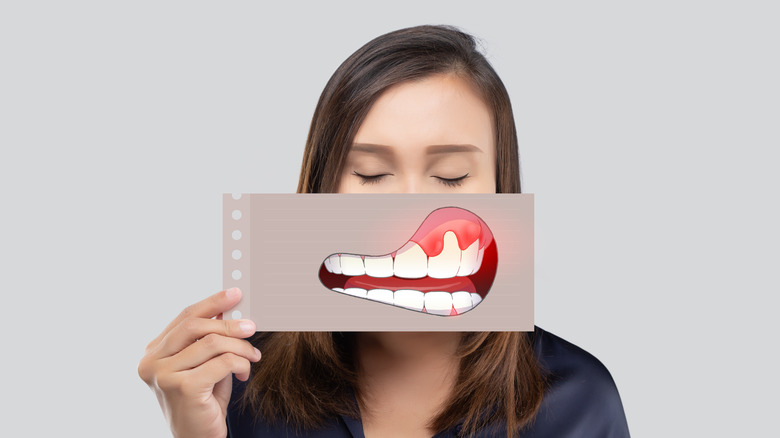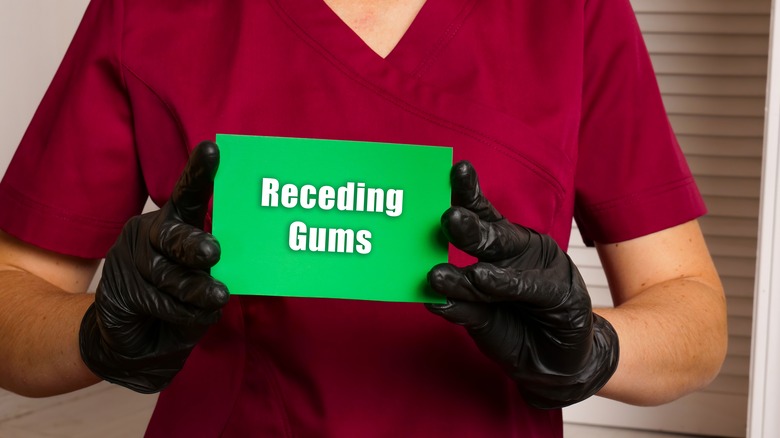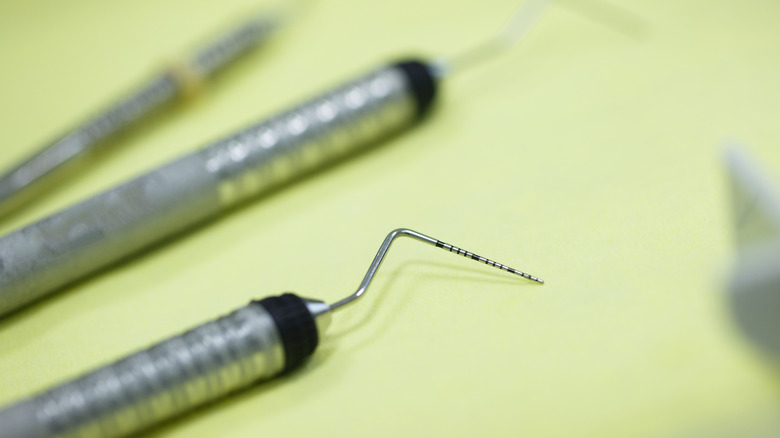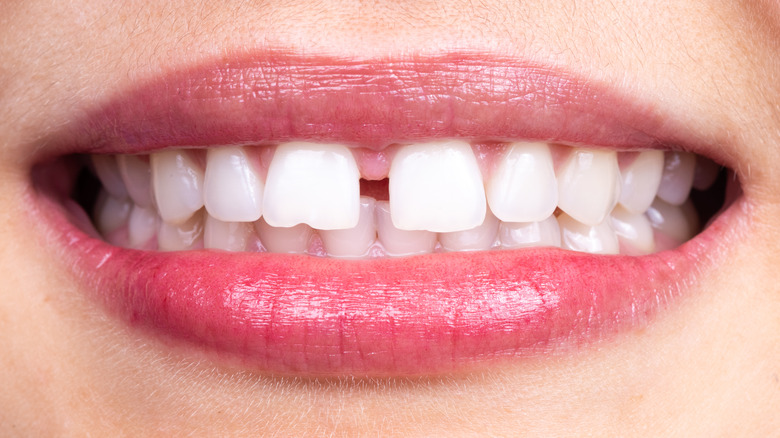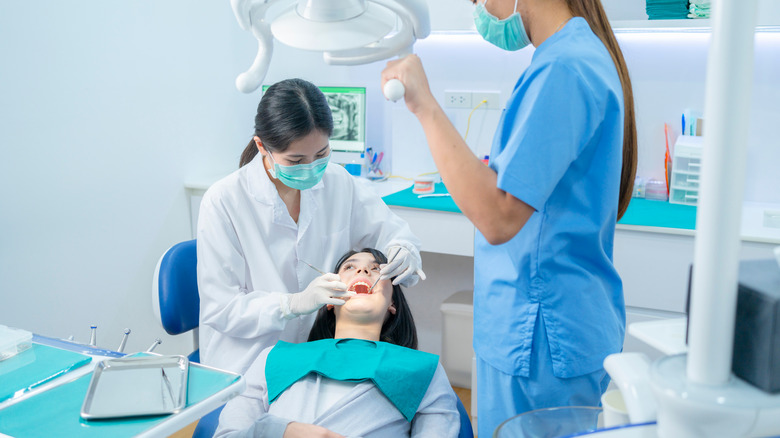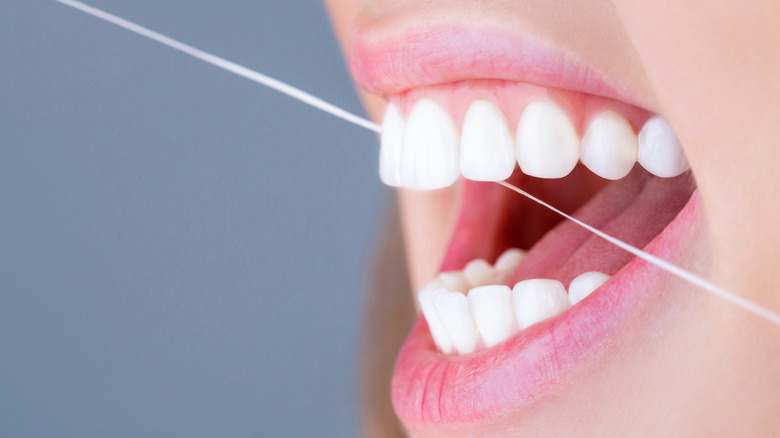Gum Disease Explained: Causes, Symptoms, And Treatments
Taking proper care of your teeth and gums is important. As you probably already know, good oral hygiene habits include brushing twice daily at a minimum, flossing every day, and visiting your dentist regularly (per Medical News Today). Unfortunately, neglecting these healthy habits can eventually lead to cavities and gum disease (periodontitis). Other factors can also impact the health of your gums, including genetics, smoking, and medications. There may even be a connection between gum disease and certain health conditions, such as heart disease.
When left untreated, gum disease can cause painful symptoms, require expensive treatments, and sometimes lead to tooth loss. One early sign of trouble is gum inflammation (gingivitis). Although The Family Dental Center describes gingivitis as the "uncalm before a gum disease storm," this condition is considered reversible. If you have gingivitis, we recommend focusing on proper oral hygiene and following all of your dentist's recommendations.
Some individuals may develop periodontitis despite their best efforts. As WebMD describes, "In a person with periodontitis, the inner layer of the gum and bone pull away from the teeth and form pockets. These small spaces between teeth and gums collect debris and can become infected. The body's immune system fights the bacteria as the plaque spreads and grows below the gum line." While periodontitis can't be reversed, you may be able to slow its progression. Depending on disease severity, your dentist may recommend nonsurgical and/or surgical interventions. Below, we discuss causes, symptoms, and treatments of gum disease.
Poor oral hygiene can cause gum disease
Most often, gum disease occurs as a result of poor oral hygiene. According to the Mayo Clinic, plaque that isn't brushed or flossed away builds up on your teeth, and it can solidify under the gum line, creating tartar and causing problems. Tartar can't be removed by brushing at home, and so requires professional cleaning at a dentist's office.
Plaque buildup can eventually lead to gingivitis, an early form of gum disease. Additionally, periodontitis can develop when pockets deepen between your teeth and gums, collecting plaque, tartar, and bacteria. Happily, you can reduce your risk of periodontitis by following standard oral health guidelines: brushing twice or more per day, flossing once a day, and visiting your dentist regularly.
Additionally, the American Dental Association (ADA) recommends using a fluoride toothpaste, drinking fluoridated water, and choosing products with the ADA Seal of Approval. They also suggest eating a healthy diet, limiting sugary foods and beverages, not using tobacco products, and avoiding oral piercings. Finally, you may wish to consider using a soft toothbrush, swishing with mouthwash, and chewing sugar-free gum (via Johnson & Johnson). For personalized oral hygiene recommendations, be sure to talk to your dentist or dental hygienist.
Hormones can impact your gum health
According to a 2015 study in the Journal of Natural Science, Biology and Medicine, female hormones may play a role in the development of gum disease: "The periodontium shows an exaggerated inflammatory response to plaque modified by female sex hormone during puberty, pregnancy, in women taking oral contraceptives and at the postmenopausal stage." In other words, you may be at increased risk for gum problems during certain stages of your life. Even menstruation may have an impact on your oral health (per the Cleveland Clinic).
The Cleveland Clinic shares that hormone therapy, specifically estrogen therapy, may benefit the gums of some postmenopausal women. This is because reduced estrogen levels during and after menopause can place women at increased risk for osteoporosis, periodontitis, and bone loss. If you notice that your gums are receding, this may be a sign of bone loss in the jaw, which can eventually lead to tooth loss. If you or your dentist think that hormones (or a lack of hormones) may be contributing to your gum issues, talk to your doctor about potential treatment options.
Other health conditions can increase your risk for gum disease
Health Grades describes a number of underlying conditions that may impact your oral health. For example, it is believed that high blood pressure can raise your risk of developing red and bleeding gums. Also, medications used to treat high blood pressure can dry out your mouth, which contributes to tooth decay.
Another related condition is heart disease. According to Health Grades, "Experts think there may be a link between oral health and heart disease, though the nature of it isn't clear. However, if you have severe gum disease — periodontitis — you are twice as likely to have heart disease. The theory is that bacteria from your inflamed gums can travel through your body and reach your heart, causing cardiovascular problems."
You may also be at increased risk for gum disease if you have kidney disease, lung disease, obesity, osteoporosis, rheumatoid arthritis, or anemia. Additionally, the Mayo Clinic cites health issues impacting immunity, like leukemia, HIV/AIDS, and cancer treatment, along with certain diseases –– diabetes, rheumatoid arthritis, and Crohn's disease –– as risk factors for periodontitis.
Medications can play a role
It is always important to discuss medication use with your dentist. Some medications may directly impact the health of your teeth and gums; others may cause related issues like unusual bleeding, changes in your sense of taste, soft-tissue reactions (such as mouth ulcers), overgrown tissue, and dry mouth (via the American Dental Association).
Dry mouth (xerostomia) is a known risk factor for the development of gingivitis and periodontitis. According to WebMD, certain drugs can impact the amount of saliva in your mouth. When the mouth is dry, mouth tissue — including the gums — can become inflamed. This may contribute to the development of tooth decay and gum disease.
If you are on medications that impact oral health, you may wish to ask your doctor whether some changes are possible. But if that's not possible, don't panic. Even when certain medications can't be avoided, your dentist can work with you to develop an appropriate treatment plan (i.e. additional cleanings) to help manage medication side effects.
Gum disease may be a result of your genes
Some people can take great care of their teeth and gums but still develop gum disease. If this sounds like you and others in your family, you may be able to blame genetics according to the American Academy of Periodontology (AAP). However, at this point, the relationship between oral health and genetics is not entirely understood. "While research is ongoing to determine the exact genetic basis of gum disease, scientists have identified 38 genes associated with the increased risk of developing periodontitis. One in particular, the FAM5C gene, has been linked to aggressive periodontal disease," according to San Diego Periodontics & Implant Dentistry. Their website also explains how FAM5C is connected to cardiovascular disease. Both gum disease and cardiovascular disease can arise from general inflammation in the body.
If you're worried you're at risk for developing gum disease, you might want to visit a periodontist. They'll perform a full evaluation, point out potential problem areas in your mouth, and help you tailor your oral health routine to your specific needs.
Bad habits can impact your gums
If you need one more reason to quit smoking, here it is: Smoking can increase your risk of developing gum disease (per WebMD). (Oh, and here are a few more: Smoking can also lead to bad breath, tooth discoloration, increased plaque and tartar build up, and even oral cancer). But how, exactly, does smoking impact the gums?
According to the Centers for Disease Control and Prevention (CDC), smoking can impact your body's ability to fight off infection, including infection of the gums. And once your gums have been damaged, smoking can also impede their ability to heal. If you are a smoker, you are twice as likely to develop gum disease as a nonsmoker. Additionally, the more you smoke and the longer you smoke, the higher your risk. Finally, gum disease treatment tends to not be as effective on people who smoke.
Smoking isn't the only bad habit that can affect the health of your gums. Any type of tobacco use, including chewing tobacco, raises your risk for gum disease. Recreational drug abuse is also problematic. Not only do drugs themselves impact the gums, they can also lead to addiction-related behavior that affects oral health. As American Addiction Centers describes, "People who struggle with addiction spend a great deal of their time intoxicated on drugs or trying to acquire more drugs; this means that they often neglect oral hygiene because they cannot afford a dentist or they simply stop caring about brushing their teeth."
You may experience red, swollen, or bleeding gums
Around 60% of people have experienced bleeding gums (via Crest). It is important to understand, though, that it's not normal and expected for gums to bleed. In fact, gums that bleed are the most common sign of gum disease (per Healthline). You may also notice additional signs of gum disease, such as red or swollen gums. If you experience any of these issues, be sure to visit your dentist as soon as possible. They can evaluate what is going on, along with making personalized treatment recommendations. In addition, we recommend consulting your doctor to explore other possible explanations. While bleeding gums are often a sign of gum disease, they can also indicate leukemia, a vitamin deficiency, or low blood platelets.
If your gums are swollen and bleeding due to gum disease, you may wish to ask your dentist whether salt water rinses could help. Of course, this would be in addition to maintaining proper oral hygiene, following a healthy lifestyle, and visiting the dentist regularly.
Receding gums are another symptom of gum disease
Gum recession is a common oral health problem, especially in the 40+ age group (via California Dental Association). It can be caused by aging, vigorous brushing, or periodontal disease. No matter the cause, gum recession will likely require some changes, starting at home. One of the first things to consider are your daily brushing habits. The California Dental Association provides some helpful brushing tips for those with receding gums: Choose a soft toothbrush, use mild to moderate pressure, and brush with circular or very small back and forth strokes. Do not use hard bristles, excessive pressure, or long horizontal brush movements.
For mild gum recession, your dentist may suggest deep cleanings (via Santa Monica Periodontics & Implant Surgery). During a deep cleaning procedure, also sometimes called root planing or tooth scaling, the gums are drawn away from the teeth so that the tooth roots can be smoothened, making it more difficult for bacteria to latch onto them. In some cases, medications are applied directly to the area, or prescribed afterward to prevent or address infection. If you are experiencing more significant gum recession, your dentist may suggest surgery. This could involve grafting gum tissue to cover exposed roots. Another possibility is bone regeneration surgery, in which medication to stimulate new growth of bone and tissue is applied to the roots of the teeth.
Gum disease can lead to bad breath or a bad taste in the mouth
If you are experiencing bad breath or a bad taste in your mouth, these may be signs of gum disease (via WebMD). If you're concerned about your breath, according to the Mayo Clinic, your dentist may smell your breath or scrape the back of your tongue (often the source of yucky odors), then use a scaled system to rate the odor. (Fun times!) Although prescribed mouthwashes and toothpastes can help, treating underlying gum disease may be necessary to resolve the issue.
Although gum disease is one possible explanation of bad breath, there are other potential causes. These include the presence of cavities, ill-fitting dental appliances, and dry mouth (xerostomia), per WebMD. If your dentist believes that the problem involves an underlying health condition, they may refer you to your primary doctor for evaluation. Additional causes of bad breath include seasonal allergies, respiratory or sinus infections, and diabetes, along with a range of other infections and diseases.
Deep pockets between teeth and gums can be a sign of gum disease
Periodontal pockets are spaces that develop around the teeth, below the gum line. While there are normally small spaces present even in a healthy mouth, these can usually be kept clean with regular brushing, flossing, and professional cleaning. However, most toothbrushes are unable to reach beyond 2-3 mm beneath the gum line, according to Dear Doctor Dentistry & Oral Health. In other words, when deeper periodontal pockets develop, food and bacteria can begin to collect and cause problems: "Pockets provide an ideal environment for bacteria to grow, and may spread infection to the structures that keep teeth anchored in the mouth."
So, how do you know if you have deep pockets? While you won't be able to see them on your own, a dentist can probe your gums and measure these spaces during an oral health exam. Healthline explains that measurements for healthy gums should fall within the 1-3 mm range. If you have mild periodontitis, 3-5 mm; for moderate disease, 5-7 mm. Anything over 7 mm is considered severe periodontal disease. While mild disease can often be treated with improved oral hygiene, moderate to severe disease may require more aggressive treatments.
Gum disease can lead to increased spaces between teeth
Spaces or gaps between your teeth are known as diastema. This can just be the way your teeth grow in, or can result from bad habits (like sucking on your fingers), abnormal tongue placement, or atypically sized, shaped, or positioned teeth (per WebMD). But gum disease is another potential cause of diastema. As Healthline explains, when inflammation causes damage to the gums surrounding your teeth, you may develop gaps between your teeth, and even tooth loss. Keep an eye out for other signs of gum disease, which include red and swollen gums, bone loss, loose teeth, and bleeding gums.
Treatment for diastema depends on its root cause. Getting braces, for example, may be an appropriate solution for some individuals. However, when diastema is the result of gum disease, your dentist will recommend other treatments. Depending on disease severity, you may wish to consider non-surgical and/or surgical methods.
Non-surgical treatment for gum disease is available
We understand that a diagnosis of gum disease can be overwhelming. Fortunately, treatments are available. If your gum disease isn't too severe, your dentist may recommend non-surgical treatment (per WebMD). For some, this is as straightforward as improving oral hygiene and getting more frequent dental cleanings than usual. Although professional cleaning is normally recommended twice a year, people with gum disease may benefit from keeping plaque and tartar buildup to a minimum.
Another treatment option is called scaling and root planing, more commonly known as deep cleaning. Scaling removes plaque buildup under the gum line; root planing smooths down the root of the tooth so that your gum can (hopefully) reattach itself. If that sounds uncomfortable, rest assured that deep cleaning is performed under local anesthesia (per the American Dental Association).
Medications can also be used to treat gum disease, according to the Cleveland Clinic. Some medications, including antibiotics, are applied between the tooth and gum, within the periodontal pocket. These are administered through a gelatin-filled chip that releases its contents gradually over a period of seven days. Your dentist may also prescribe specialized toothpaste or mouth rinses.
Surgery may be necessary to treat gum disease
When gum disease is more advanced, surgery may be recommended. In this case, there are several possible techniques. The first, known as flap surgery, involves lifting the gums back, cleaning the area, and suturing the gums back in place so they are snug around the tooth, according to Medical News Today.
Alternatively, you may benefit from a bone or soft tissue graft. Bone grafts replace bone that has been destroyed by gum disease (via the Cleveland Clinic). The bone that is used can be your own, donated, or synthetic. A soft tissue graft, on the other hand, "strengthens thin gums or fills in places where gums have receded." Tissue is typically removed from the roof of your mouth, then stitched into place. A related technique, known as guided tissue regeneration, stimulates growth of both bone and tissue.
Another surgical gum treatment is bone surgery. This is usually performed after flap surgery (per WebMD). In this case, a surgeon reshapes the bone around the tooth to reduce any indentations that have developed. This helps keep bacteria from collecting in the future.
Gum disease may be preventable
Let's face it: Gum disease is no party. The good news is that it is largely preventable. To avoid unnecessary pain, discomfort, and possible tooth loss (along with massive dental bills!), Listerine recommends brushing, flossing, and rinsing with antiseptic mouthwash twice daily. They also encourage patients to see their dental provider at least every six months, as well as anytime they experience symptoms of gum disease. Finally, consider eating a healthy, balanced diet and avoiding smoking.
If you do develop gum disease, we want you to know that you're not alone. The CDC provides the following statistics: Almost half (47.2%) of adults aged 30 and older experience some form of periodontal disease. You are even more likely to develop periodontitis as you age, with about 70% of adults 65 years and older suffering from the condition. Periodontal disease is more likely to occur in men than in women (56.4% versus 38.4%), as well as in those living in poverty (65.4%). Also at an elevated risk are people who smoke (64.2%). If you can't afford to visit a dentist, there may be help available. The CDC provides resources on finding affordable dental care.








